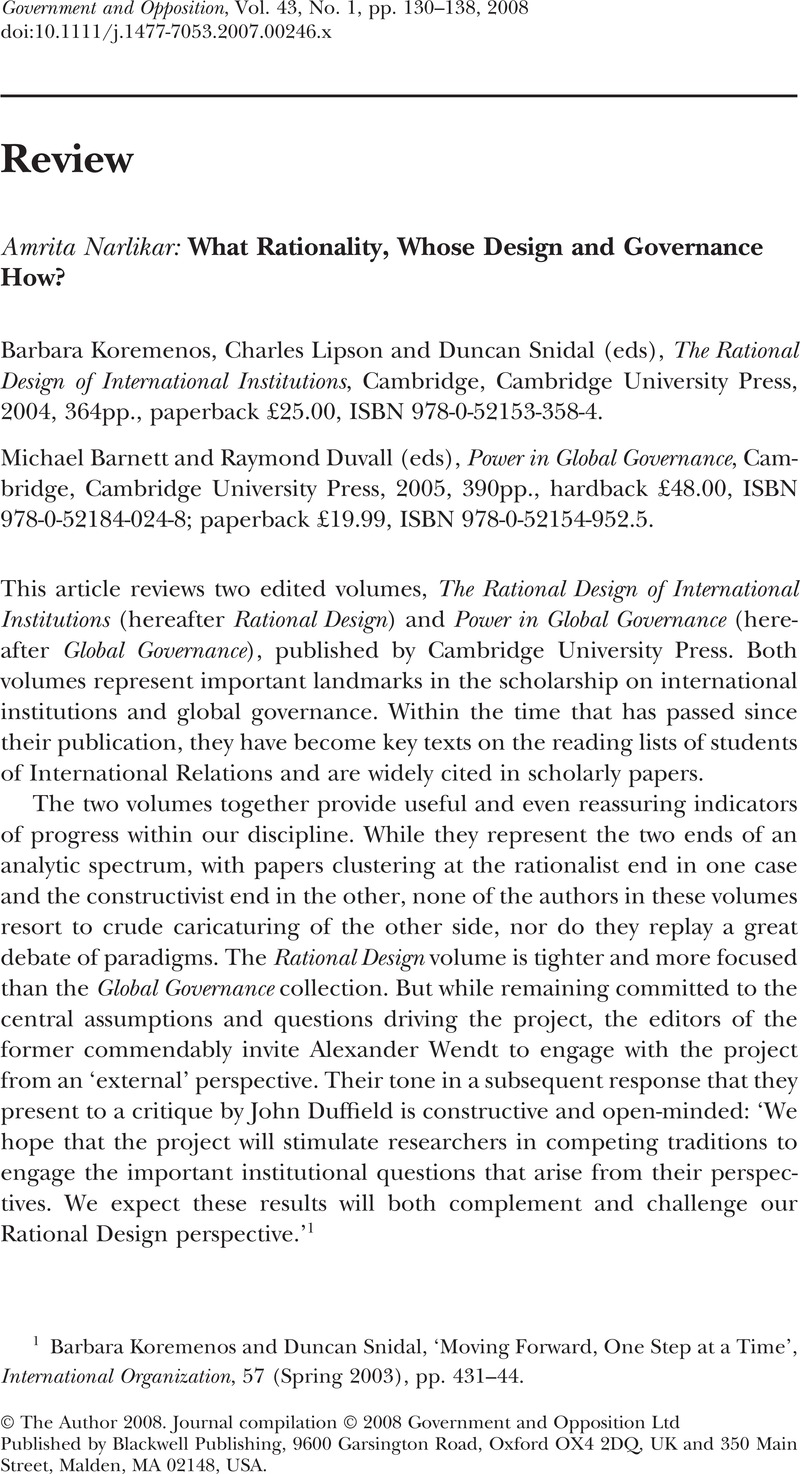No CrossRef data available.
Article contents
What Rationality, Whose Design and Governance How?
Published online by Cambridge University Press: 28 March 2014
Abstract

- Type
- Review
- Information
- Copyright
- Copyright © Government and Opposition Ltd 2008
References
1 Koremenos, Barbara and Snidal, Duncan, ‘Moving Forward, One Step at a Time’, International Organization, 57 (Spring 2003), pp. 431–44.CrossRefGoogle Scholar
2 Katzenstein et al. identify the debate between rationalism and constructivism as the ‘main point of contestation’ in international political economy; see Katzenstein, Peter, Keohane, Robert and Krasner, Stephen, ‘ International Organization and the Study of World Politics’, International Organization, 52 (Autumn 1998), pp. 645–85Google Scholar. Partly in response to this, Fearon and Wendt offered a different view: ‘… the most interesting research is likely to be work that ignores zero-sum interpretations of their relationship and instead directly engages questions that cut across the rationalist/constructivist boundary as it is commonly understood.’ See James Fearon and Alexander Wendt, ‘Rationalism v. Constructivism: A Sceptical View’, in Walter Carlsnaes, Thomas Risse and Beth Simmons (eds), Handbook of International Relations, London, Sage, 2002, pp. 52–72.
3 Amanda Dickins coins these graphic terms in her paper, ‘The Evolution of International Political Economy’, International Affairs, 83: 3 (2006), pp. 479–92Google Scholar: ‘The predominant type in the United States is the rationalist species, Ratiosaurus rex…. By contrast, members of the diverse critical species that comprise the genus Querimonia, dominant in the United Kingdom and Canada, expend much effort uncovering the hidden workings of hegemony …’. In keeping with the geographical distinction that Dickins identifies, all the 14 contributors of the Rational Design papers are based at US institutions; the Global Governance collection shows greater transatlantic dialogue, with six of the 16 contributors having primary institutional affiliations in Canada and Europe.
4 Rational Design, p. 2.Google Scholar
5 Ibid., p. 21.Google Scholar
6 For an insightful analysis of the relative utility of the case studies, and a discussion of the ones that seem to fit less comfortably in the volume than others, see Duffield, John, ‘The Limits of “Rational Design” ’, International Organization, 57 (Spring 2003), pp. 411–30.CrossRefGoogle Scholar
7 The editors recognize up front that their bivariate analysis cannot capture the complex interaction between the different variables and the resulting conflict and complementarities between the particular ‘design principles’. But an explanation for the selection of certain bivariate conjectures over others precedes the question of complex interaction.Google Scholar
8 This point has been explored in detail in Amrita Narlikar and John Odell, ‘Negotiating International Institutions: Institutional Change from the GATT to the WTO’, paper presented at ISA, San Diego, March 2006.Google Scholar
9 Ibid.Google Scholar
10 Michael Barnett and Raymond Duvall, ‘Power in Global Governance’, in Global Governance, p. 7.Google Scholar
11 Ibid., p. 7.Google Scholar
12 Ibid., pp. 11–12.Google Scholar
13 The reference to a ‘bum deal’ is drawn from Sylvia Ostry's line about the Uruguay Round: ‘The Grand Bargain turned out to be a Bum Deal’, Sylvia Ostry, ‘The Multilateral Agenda: Moving Trade Negotiations Forward’, MCIS Briefings, Munk Centre for International Studies, University of Toronto, November 2005, available at http://webapp.mcis.utoronto.ca/resources/MCIS_Briefings/OSTRYBriefing.pdf.Google Scholar
14 For recent developments in this research agenda, see John Odell (ed.), Negotiating Trade: Developing Countries in the WTO and NAFTA, Cambridge, Cambridge University Press, 2006; and Narlikar and Odell, ‘Negotiating International Institutions’.Google Scholar




